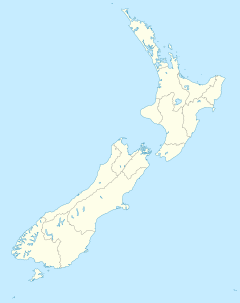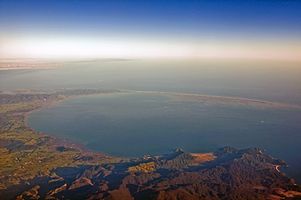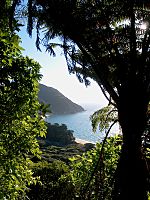Golden Bay facts for kids
Quick facts for kids Golden Bay / Mohua |
|
| Bay | |
| Country | New Zealand |
|---|---|
| Coordinates | 40°40′S 172°50′E / 40.667°S 172.833°E |
Golden Bay / Mohua is a shallow, paraboloid shaped bay at the northwest end of New Zealand's South Island. An arm of the Tasman Sea, the bay lies northwest of Tasman Bay and Cook Strait. It is protected in the north by Farewell Spit, a 26 km long arm of fine golden sand which is the country's longest sandspit. The Aorere and Takaka Rivers flow into the bay from the south.
It is known for being a popular tourist destination, because of its good weather and relaxed, friendly lifestyle. The bay was once a resting area for migrating whales and dolphins such as Southern Right Whales and Humpback Whales, and Pygmy blue whales may be observed off the bay as well.
The west and northern regions of the bay are largely unpopulated. Along its southern coast are the towns of Takaka and Collingwood, and also the Abel Tasman National Park. Separation Point, the natural boundary between Golden and Tasman Bays is situated within the park. Basal part of the spit approaches to the North West Nelson National Park.
In December 2011, it (as well as much of the Nelson/Tasman region) was hit by heavy rain and flooding, which affected many homes around the Pohara/Ligar Bay/Tata Beach/Wainui area. The road to Totaranui, a popular isolated tourist destination in Tasman Bay was badly damaged and was reopened on 29 June 2012.
Its beaches like Tata Beach are popular locations for retirees and holiday-homes.
It is located in the Tasman Region, one of the territorial authorities of New Zealand.
History
Maori lived along the shores of Golden Bay from at least 1450 which is the earliest dated archaeological evidence (from carbon dating) yet found. In 2010 an extensive scientific study was made of Golden Bay by a team from Otago University led by I Barber. They accurately plotted and investigated a large number of early Maori sites ranging from pā to kainga to probable kumara gardens that stretch along the coastal arc from the base of Farewell Spit at Triangle Flat, 60 km eastwards to a pā site 10 km east of Separation Point. The iwi, who had only recently occupied this area in 1642, were the Ngati Tumatakokiri from the North Island.
Dutch explorer Abel Tasman anchored 7 km out from in this bay in 1642, and in a bloody encounter, Ngati Tumatakokiri rammed the Dutch ship's boat with a waka and killed 4 Dutch seamen - for which Tasman named it Moordenaar's Bay (Murderers Bay). Ian Barber postulated that the iwi may have been insecure in their control of the bay and its resources because of their own relatively recent arrival. Little is known of the history of Ngati Tumatakokiri people as they were extinguished by a Maori invasion during the Musket Wars about 1823.
Tasman saw at least 22 waka. He recorded that of the 11 waka who chased his ship, most had 17 men on board. This gives a total of about 200 men, with a likely population of about 500 people. Tasman had already been in the bay for 5 days when attacked giving the Maori time to assemble an attack force. Archaeological evidence has not shown any large settlements so it is likely that the iwi normally lived in whanau based groups scattered along the coast but mainly in the eastern bay at Ligar Beach, Tata Beach and Wainui Bay where there are 20 known archaeological sites in a 10 km zone.
In 1770, during his first voyage, English explorer James Cook included the bay as part of Blind Bay, but upon his second voyage to the bay in 1773 realised that it was in fact the location of Murderers Bay. The French explorer Jules Dumont d'Urville appears to have changed the name to Massacre Bay.
European settlement commenced in October 1842 with the Lovell family settling at Motupipi near the then existing Maori pa site. Prior to the Lovell's settling, in March of that year a Mr Tuckett had discovered coal on the beach near the Motupipi pa. There was a report from May 1841, which also stated there was coal in the area. In the 1840s, following the discoveries, the local population unsuccessfully sought to have it renamed Coal Bay. Then, in the late 1850s, with the discovery of gold in at Aorere, its name was changed to Golden Bay.
In August 2014, the name of the bay was officially altered to Golden Bay / Mohua.





